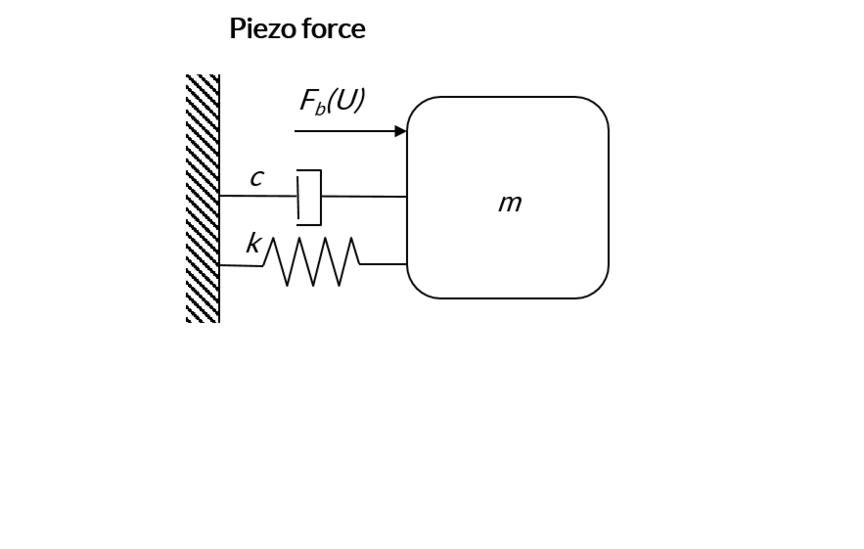What is a dynamic application?
In a dynamic application, the dynamic forces (inertia or mass multiplied by acceleration) and damping forces (force depending on speed) are not negligible. As a result, the system cannot be modeled by simple linear equations, but by differential equations.
The limit between a static and a dynamic application depends on many parameters. If a mechanical resonance is present at less than three times the operating frequency, then the application is dynamic. Fast driving signals (steps) also call for a dynamic analysis.
Simple dynamic model
In a static application, a piezoelectric actuator can be modeled as a spring, with a characteristic that can be offset by an electrical field. For a dynamic application, this model has to be expanded to include at least the damping and mass of the moving part (piezo + load). The piezo effect can be modeled as an external force, proportional to the voltage, acting on the load.
In this approach, the system is equivalent to a damped harmonic oscillator, driven by the piezoelectric force. This means that for a given driving force (i.e. voltage amplitude) with an increasing frequency, the amplitude of the displacement will increase up to the mechanical resonance, then decrease. Phase will change from 0 to 180°. The amplification factor due to resonance can be substantial, leading to increased stress on the piezo element. Therefore, in most cases the excitation signal will need to be reduced around resonance.
Limitations
It is important to know what limits the performance of the piezoelectric actuator in the application. Limitations can be of three types:
- Voltage-related. Actuators are designed for a certain voltage range. Operation outside of that range is not recommended as it could cause electrical failure (arcing) or accelerated ageing.
- Stress-related. Actuators are specified for a certain stress range. For example, the plate stacks are recommended in the range +10 to +80MPa, although in extreme cases they can be used in the range -5 to +150MPa. Tensile stress can result in a mechanical damage while compressive stress leads to a degradation of the poling.
- Temperature-related. Although the normal operating range of piezo actuators is very wide (for example 4mK to 470K/200°C for NCE51 products), self-heating is a concern for high frequency operation.
Since stress and self-heating are directly related to frequency, it is important to understand the dynamics of a system in order to validate the design of the piezoelectric element.
Sign up for our webinars
Our free 1.5 hour webinars follow the same structure as our tutorials.
A piezo partner - what do we mean by that

We give you a competitive advantage by using our extensive knowledge to customize and optimize your piezo products. Thus, we will be your long-term piezo partner. Send your request today.
Search tool
- Plate actuators
- Plate stacks
- Ring actuators
- Ring stacks
- Plate benders
- Ring benders
- Shear plate actuators
- Shear stacks
- 2D actuators
- High temperature stacks
- Damage tolerant stacks
- NCE51
- NCE51F
- NCE46
- NCE57
- NCE40
- NCE41
- NCE55
- NCE56
- NCE59
- NCE81
- 0,00
- AA
- Material
- Type
- 0.00



